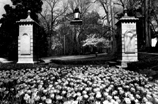

Dedicated in 1937, the gateway is now used as a pedestrian walkway, which has not always been the case. When it was built, it straddled Mizell Drive, one of Emory's main vehicular thoroughfares. Over the years, a series of accidents led the University to divert traffic around the gateway. In 1947, its lamp and metal framework were smashed twice by high-topped trucks, which led to a ban on those kinds of vehicles using that entrance. Then, in 1971, a tractor-trailer driver who was obviously unfamiliar with the truck moratorium barreled through and damaged the framework again. After that final assault, the road was changed so no traffic passed under the gateway.
The Haygood-Hopkins Memorial Gateway is one of the University's most familiar icons. The fifty-nine-year-old monument is composed of two marble pillars connected by an ornate, wrought iron arch. At the center of the span is a lantern, which has become a trademark of the University and which appears on the Graduate School of Arts and Sciences' gonfalon.
Facing the gateway, the pillar on the left is dedicated to Atticus Greene Haygood, who graduated from Emory College in 1859, fifty-six years before the University moved from Oxford to Atlanta. Known as a preacher and a philanthropist, Haygood served as president of Emory from 1875-84. From 1878-82 he was editor of the Wesleyan Christian Advocate, and from 1890 until his death in 1896 he was a bishop of the Methodist Episcopal Church, South. Two quotations attributed to Haygood are inscribed at the base of the pillar: "Nothing praises or pleases God like service," and "Let us stand by what is good and try to make it better."
The opposite pillar is dedicated to Isaac Stiles Hopkins, also an 1859 graduate of Emory College. A minister as well as a teacher, Hopkins was president of Emory from 1884-88. Following his tenure in Oxford, he went on to be the founder and first president of the Georgia School of Technology (forerunner of the Georgia Institute of Technology). Words etched in the marble beneath the details of his life describe Hopkins as "A pioneer in technical education, he was one of the builders of the New South."
The gateway was a gift of Linton B. Robeson, a member of the Class of 1886. A partner in the Boston publishing house Ginn & Company, he was a member of the College Board of Trustees for fifteen years and president of the alumni association for a decade. Robeson's undergraduate years spanned the tenures of both Haygood and Hopkins, whom Bishop Warren Candler said "kept Emory College alive in the Reconstruction days following the Civil War."
On October 8, 1937, Robeson delivered an address in Glenn Memorial Auditorium in honor of the gateway's dedication. During his remarks, he said, "In thinking over what I could do to honor these two great and good men, Haygood and Hopkins, and keep their names before the youth of the land, it occurred to me that a gateway at the entrance to the campus of Emory University would be the best thing. I thought it would serve to bring the `Old Emory' a little closer to Emory University, and to link the two together, and to remind the present and future generations of the fact that Emory is a great institution and has a great history extending back many years before it was moved to Atlanta." --J.D.T.
Click here to return to Emory University Home Page.